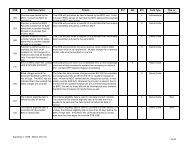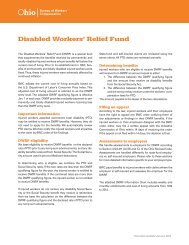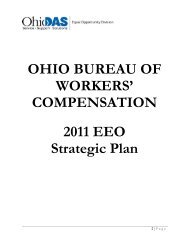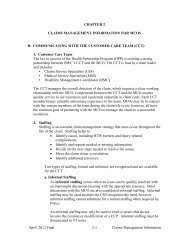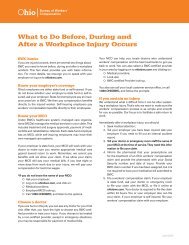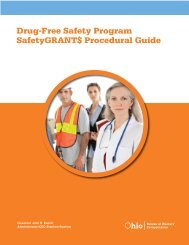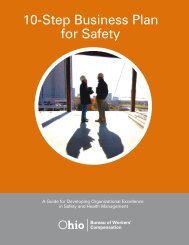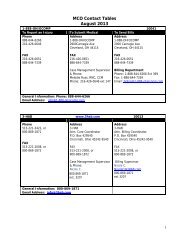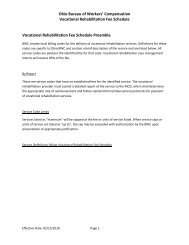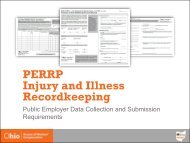Electrical safety
Electrical safety
Electrical safety
Create successful ePaper yourself
Turn your PDF publications into a flip-book with our unique Google optimized e-Paper software.
<strong>Electrical</strong> <strong>safety</strong><br />
by Warren K. Brown<br />
Before you begin<br />
O To understand electrical <strong>safety</strong> and the<br />
sequence of topics, review the material as<br />
well as the resources.<br />
O Make a list of examples of electrical hazards<br />
from your home, office and the workplace.<br />
O Display a few items such as a portable<br />
ground fault circuit interrupter (GFCI), an<br />
extension cord, a lockout lock and toolbox<strong>safety</strong><br />
talks.<br />
Introduction<br />
Electricity is at home, at work and in our recreational areas.<br />
It provides the energy that makes many of our tasks much<br />
easier and life more pleasant. It powers machinery, provides<br />
heating and cooling, energizes lights, pumps our<br />
water and runs home and office equipment. When used<br />
correctly, electricity essentially goes unnoticed. But, if<br />
something goes wrong, there may be injuries, death, fires<br />
and costly equipment and building damage. We will discuss:<br />
O Basic electricity concerns;<br />
O How we can get into trouble with electricity;<br />
O How to avoid electrical hazards.<br />
Discussion<br />
Each year, there are more than 30,000 non-fatal electrical<br />
injuries, and more than 411 people die from electrocution.<br />
<strong>Electrical</strong> problems cause approximately 25 percent of<br />
fires. People could have avoided most of these incidents.<br />
To organize the efforts of bringing electricity into society,<br />
code organizations began writing codes to avoid undesirable<br />
consequences. Underwriters Laboratories and the<br />
National Fire Protection Association (NFPA) are examples<br />
of these code organizations. In addition, they make the<br />
use of electricity safer.<br />
Definitions<br />
To understand electricity, it is important to know some<br />
basic definitions.<br />
O Current - Measured in amperes, it is the movement<br />
of an electrical charge.<br />
O Resistance - Measured in ohms, it is the opposition<br />
to current flow.<br />
O Voltage - Measured in volts, it is the measure of electrical<br />
force.<br />
O Conductors - They are materials with little resistance<br />
to electrical current flow.<br />
O Insulators - They are materials with high resistance<br />
to electrical current flow.<br />
O Grounding - It is a conductive pathway that permits<br />
electrical current flow to the earth. This is part of the<br />
electrical <strong>safety</strong> protective system.<br />
O Shocking current - It is an electrical current that<br />
passes through a body part. The shock’s severity<br />
depends on the voltage, amperage and resistance.<br />
The greater the current, the greater the shock.<br />
O Arc flash/blast - This is the resulting flash and pressure<br />
wave when an electrical fault occurs. The temperature<br />
may approach 35,000 degrees Fahrenheit<br />
and molten components may cause serious injuries.<br />
When the human body becomes part of an electrical path<br />
or circuit, injuries may occur. These include shock, burns,<br />
nerve/organ damage, loss of vision and death. In addition,<br />
other secondary results such as falls may happen.<br />
BWC’s Division of Safety & Hygiene<br />
Safety Talk
An electrical shock’s severity depends on the quantity of<br />
the current, the electricity’s path through the body and the<br />
length of time the current passes through the body.<br />
Electricity that is out of control may result in fire, explosions<br />
and equipment damage. The distance from an arc/<br />
blast along with enclosure and personal protective equipment<br />
determine how it will affect the body.<br />
Group action<br />
O Ask the participants to identify root causes of electrical<br />
incidents. They may include unsafe equipment installations,<br />
environmentally induced concerns and work<br />
practices.<br />
O Ask the participants to identify key electrical <strong>safety</strong><br />
considerations related to the equipment their facility<br />
uses. Their answers should include those listed<br />
below.<br />
Insulation<br />
Insulation protects workers from direct contact with energized<br />
equipment. Check the wiring for intact insulation.<br />
Make sure the wiring methods protect the insulating properties<br />
from damage. For example, you can use conduit for<br />
protection or it could be the wiring that is behind the drywall<br />
in your house.<br />
Short circuits<br />
Short circuits in equipment may result in electrically energized<br />
equipment. The worker who touches this equipment<br />
may become part of the path to ground and may suffer an<br />
injury or death. If there is damage to an electrical device,<br />
have a qualified electrician check it to ensure there are no<br />
electrical faults.<br />
Grounding<br />
Grounding is an important <strong>safety</strong> issue. It ensures exposed<br />
metal equipment connects to a low resistance electrical<br />
path to ground. If the insulation fails, the fault protection<br />
will operate to protect the worker from an electrical<br />
shock.<br />
You must appropriately enclose exposed current-carrying<br />
devices to prevent inadvertent contact and protect from<br />
an arc flash/blast. Such a blast could result in bodily injury<br />
or equipment damage.<br />
List<br />
Ask the participants to develop a list of do’s and don’ts for<br />
electrical <strong>safety</strong>. Write their responses on a flip chart or a<br />
white board. To compare here are examples.<br />
Do’s<br />
O The cord plugs should match the receptacle.<br />
O Trained and qualified electricians should do any electrical<br />
repairs.<br />
Don’ts<br />
O Don’t use cords in water; hot or exposed mechanical<br />
environments could damage the insulation.<br />
Ask the group members to identify the types of emergencies<br />
that could occur as a result of an electrical incident and<br />
the actions they should take. Here are examples.<br />
O If there is a fire, call trained firefighters before you<br />
attempt to extinguish it. Only attempt to extinguish a<br />
fire if you have fire-extinguisher training.<br />
O If a person is hurt from electrical contact, summon<br />
medical help first. Then, perform the levels of first aid<br />
your training allows you to do.<br />
Group action<br />
To look for electrical hazards, ask employees to do a walkaround<br />
inspection of their work areas. Schedule time for a<br />
group discussion of their findings and the solutions they<br />
proposed for each identified concern. Conduct a follow-up<br />
inspection to verify there is corrective action.<br />
References<br />
Publications<br />
O National Safety Council (NSC) Accident<br />
Prevention manual<br />
O National Fire Protection Association National <strong>Electrical</strong><br />
Code (NFPA 70)<br />
O Occupational Safety and Health Administration 29CFR<br />
1910 Subpart S<br />
O ASSE Safety Professionals Handbook – Technical<br />
Applications<br />
Slide presentation<br />
Warren K. Brown is a certified <strong>safety</strong> professional, an<br />
associate in risk management and a certified <strong>safety</strong> and<br />
health manager. He is retired from General Motors, Delphi<br />
and DMAX Ltd. He also taught <strong>safety</strong> at Dayton’s Sinclair<br />
Community College. A General Motors Safety Fellow and<br />
Safety Professional of the Year for Ohio and Region 7 of the<br />
American Society of Safety Engineers (ASSE), Brown was<br />
ASSE’s president from 2008 to 2009.<br />
In addition, he is a National Safety Council Distinguished<br />
Service to Safety award recipient, and he is serving a sixyear<br />
term on the board of directors for the Institute for<br />
Safety and Health Management. Brown also serves on the<br />
board of directors for Dayton’s Miami Valley Safety Council<br />
and he is past president of the Ohio Valley Section of the<br />
American Industrial Hygiene Association.<br />
BWC always strives to improve the Safety Leader’s Discussion<br />
Guide. Your feedback can help. Please send your comments<br />
via e-mail to discussionguide@bwc.state.oh.us.<br />
BWC is not associated with any of the websites, and we do<br />
not endorse them.<br />
From the 2010 Safety Leader’s Discussion Guide




